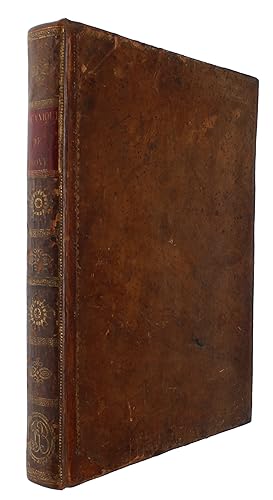Beschreibung
Paris, Imprimerie de la République, an VIII [i.e. 1800]. 4to. Bound in a lovely full mottled calf binding with fine, gilt ornamental borders to boards, double gilt line-borders to all edges of boards and a richly gilt spine. Spine with gilt red leather title-label and with the gilt monogram of Joséphine and Napoléon - "JB" - to lower spine. Neatly rebacked. With a handwritten inscription for Napoleon to title-page "Au Citoyen Bonaparte/ premier Consul de la République francaise/ De la part du Conseil [de]/ L'Ecole Polythechnique", with a signature underneath and the stamp of the Ecole Polytechnique. The inscription is slighly cropped at the outer margin. A bit of brownspotting here and there. (4), VII, (1), 477, (3) pp. First edition, original offprint from Journal Polytechnique, Tome III, Cahiers 7 & 8, of Prony's magnum opus "Mécanique phlilosophique". The three parts here are all that appeared, as the planned two parts announced on the verso of the extra title-page never appeared. A truly splendid copy from Napoleon's library, with the gilt monogram of him and Joséphine from the library at Malmaison and with a presentation-inscription for Napoléon, which is rare. Books from the library at Malmaison do occasionally appear on the market, although they are rare. They are usually taken to be mainly Joséphine's, as she spent more time there. This, however, is a rare exception. First, we know that Napoléon actually did spend time at Malmaison at the time that he was given the present volume, around 1800, second, it bears an inscription for him, which is rare, determining for a fact that this was one of his books, not Joséphine's. Together with the Tuileries, Malmaison was the French government's headquarters from 1800 to 1802, exactly the time that Napoleon will have been given the present book and incorporated it in his library. Many of the books at the Malmaison library were books on things like gardening that Joséphine cared a great deal about. These were clearly her books. And some of the books, like the present, were clearly those of Napoleon himself. Napoleon was a voracious reader and he spent much time in his library studying his books. He had a personal librarian, always travelled with books, and took pride in constructing portable libraries as well as the rooms for his own actual library. On 9 July 1800, he gave the commission for a study to be built in place of the three small rooms situated on the south corner pavilion of Malmaison. Fontaine removed the partition walls and commissioned the Jacob brothers to make the teak woodwork. On 18 September, Fontaine wrote: ?Everything is now in place, and even though the First Consul found that the room looked like a church sacristy, he was nevertheless forced to admit that it would have been difficult to do better in such an unsuitable space? The paintings of the great ancient and classical authors which surround Apollo and Minerva on the ceiling were probably executed by Lafitte. Napoleon had been an avid reader since he was quite young, and when he began studying at the École Militaire in Paris, he continued to read classics, literature, and philosophy, as he would throughout his life, but he also read more scientifically and strategically aimed books. ?His appetite for reading books continued as he rose in power. In 1798, about to depart on the Egyptian campaign, he gave Bourrienne a list of books he wanted in his camp library. These included works in Sciences and Arts (e.g., Treatise on Fortifications), Geography and Travels (e.g., Cook?s Voyages), History (e.g., Thucydides, Frederick II), Poetry (e.g., Ossian, Tasso, Ariosto), Novels (e.g., Voltaire, Héloïse, Werther and 40 volumes of ?English novels?), and Politics and Morals (the Bible, the Koran, the Vedas, etc.)? (Shannon Selin: Bonaparte the Book Worm), giving us a great insight into his preferences at the time. Prony, with his great Mechanical Philosophy, will have fallen perfectly amongst these great writers, when. Bestandsnummer des Verkäufers 60104
Verkäufer kontaktieren
Diesen Artikel melden
![]()




